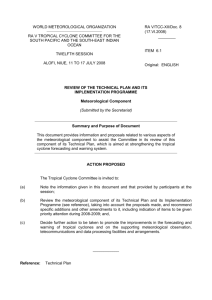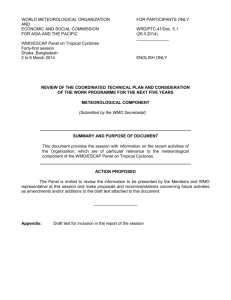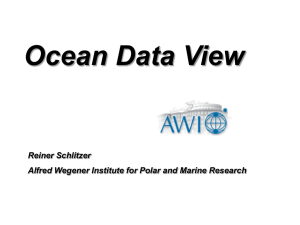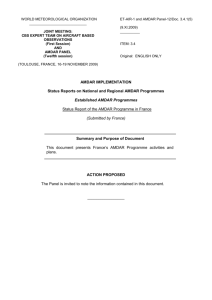REVIEW OF THE TECHNICAL PLAN AND ITS
advertisement
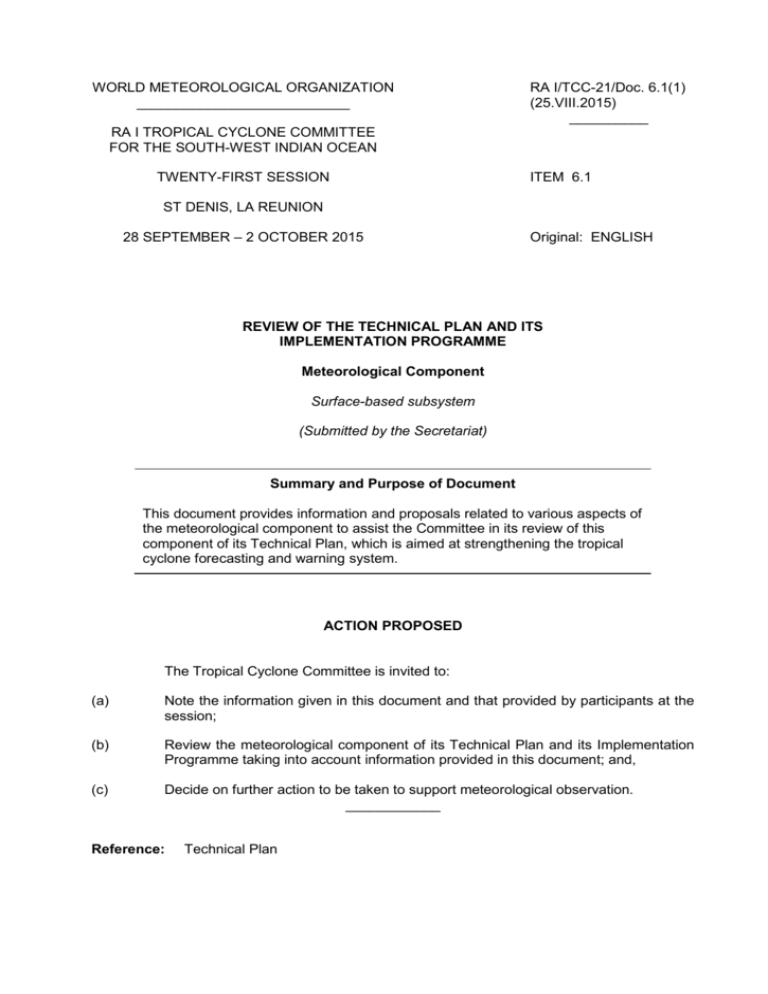
WORLD METEOROLOGICAL ORGANIZATION ___________________________ RA I/TCC-21/Doc. 6.1(1) (25.VIII.2015) __________ RA I TROPICAL CYCLONE COMMITTEE FOR THE SOUTH-WEST INDIAN OCEAN TWENTY-FIRST SESSION ITEM 6.1 ST DENIS, LA REUNION 28 SEPTEMBER – 2 OCTOBER 2015 Original: ENGLISH REVIEW OF THE TECHNICAL PLAN AND ITS IMPLEMENTATION PROGRAMME Meteorological Component Surface-based subsystem (Submitted by the Secretariat) Summary and Purpose of Document This document provides information and proposals related to various aspects of the meteorological component to assist the Committee in its review of this component of its Technical Plan, which is aimed at strengthening the tropical cyclone forecasting and warning system. ACTION PROPOSED The Tropical Cyclone Committee is invited to: (a) Note the information given in this document and that provided by participants at the session; (b) Review the meteorological component of its Technical Plan and its Implementation Programme taking into account information provided in this document; and, (c) Decide on further action to be taken to support meteorological observation. ____________ Reference: Technical Plan RA I/TCC-21/Doc. 6.1(1), p. 2 6.1 METEOROLOGICAL COMPONENT (GLOBAL OBSERVING SYSTEM) REGIONAL BASIC SYNOPTIC NETWORK (RBSN) 6.1.1. The Regional Basic Synoptic Network (RBSN), being a minimum regional requirement to permit members to fulfill their responsibilities within the WMO World Weather Watch (WWW) Programme, continued to provide a fundamental basis for weather analysis and forecast and for tropical cyclone warning services in Region I. Overall, the countries of the region are contributing to the implementation of the RBSN (August 2015) by operating a total of 782 surface and 81 upper-air synoptic stations of which 234 surface + 19 upper-air synoptic stations are located in countries in the area of the RA I Tropical Cyclone Committee. The details of the observational programmes provided by these stations are given in Weather Reporting (WMO-No. 9, Volume A), and available on the WMO website at http://www.wmo.int/pages/prog/www/ois/ois-home.html. 6.1.2. The quarterly Integrated WWW Monitoring (IWM) exercise of the operation of the WWW provides information on the performance level of the observing and telecommunications systems. A summary of the analysis following the results of the monitoring carried out during the intersessional period, showing the availability of the SYNOP and TEMP reports from the RBSN stations in the area of the RA I Tropical Cyclone Committee, is provided in the table below. It should be noted that while a number of surface stations had slightly increased between 2011 and 2014, that the overall percentage of the SYNOP reports received had shown a small decrease. However, a number of upper-air stations as well as the overall percentage of TEMP reports received had shown a significant decrease during this period; see the details in the table below. The community should be alarmed by this trend and decide on actions to rectify the situation, including implementation of alternative cost-effective observing systems; see sections 6.1 to 6.1.6. RBSN stations in the area of the RA I Tropical Cyclone Committee Quarterly Integrated WWW Monitoring (IWM) of the Operation of the WWW, availability of SYNOP/TEMP data at MTN Centres (Period July 2010 – April 2011 and July 2013 – April 2014) Country/Area Botswana Comoros French Islands Kenya Lesotho Madagascar Malawi Mauritius Mozambique Namibia Seychelles South Africa Swaziland Tanzania Zimbabwe Total Number of surface stations / (%) of SYNOP reports received 2011 2014 12 2 8 18 3 26 2 6 15 15 3 87 1 16 17 231 61% 95% 98% 63% 3% 49% 19% 91% 39% 46% 32% 84% 45% 49% 53% 66% 15 2 8 11 3 26 2 6 27 15 3 82 1 15 18 234 51% 86% 55% 74% 15% 54% 44% 92% 30% 71% 64% 94% 47% 82% 52% 61% Number of upper-air stations / (%) of TEMP reports received 2011 2014 5 3 2 2 1 2 3 1 10 3 2 34 1% 39% 20% 70% 0% 26% 0% 28% 28% 4% 7% 20% 4 2 1 2 1 1 2 1 1 3 1 19 0% 23% 33% 32% 0% 6% 0% 40% 84% 8% 3% 15% RA I/TCC-21/Doc. 6.1(1), p. 3 6.1.3. Sustainability of basic networks in some parts of the region and the low availability of data from those networks remain an issue of concern which emphasizes the need to further strengthen basic networks, especially those in developing and the least developed countries. For more details on the Integrated WWW Monitoring (IWM) results, see http://www.wmo.int/pages/prog/www/ois/monitor/index_en.html. AIRCRAFT OBSERVATIONS 6.1.4. The aircraft-based observing system, comprising the AMDAR observing system1 supplemented by aircraft observations derived from ICAO systems, now produces nearly 800,000 upper air observations per day on the WMO GTS, with the AMDAR system contributing the vast majority and around 770,000 observations from 38 participating airlines and a global fleet of around 4500 aircraft. This critical sub-system of the WMO Integrated Global Observing System produces both upper tropospheric enroute and vertical profile (from AMDAR aircraft at airport locations) high quality, upper air temperature and wind data, that continues to demonstrate a significant positive impact on global, regional and high resolution NWP and other forecasting and meteorological applications. With the advent and scientific validation of the Water Vapour Sensing System, WVSS-II, for jet aircraft, there is a growing number of aircraft (currently 127 aircraft, chiefly providing data over the US) operationally providing vertical profiles of high quality atmospheric moisture data. This means that AMDAR can now be considered as a complete upper air sounding system providing a high quality and high impact supplement to radiosonde data. Also, given its comparatively significantly lower establishment and running costs2, AMDAR might be considered as an alternative to radiosondes when resources and/or technical capabilities of countries are limited. 6.1.5. Since the previous TCC session, little has changed in regard to the status of aircraftbased observations and AMDAR data coverage over RA I. The South African AMDAR Programme is still the sole AMDAR Programme in the region, with an increased fleet of 56 South African Airways aircraft, now providing around 5000 upper air observations, including around 100 vertical profiles per day on the GTS. The coverage over the region is supplemented by voluntary and contracted contributions from EUMETNET via the E-AMDAR programme, which provides additional vertical profiles over a limited number of airports throughout Africa. The figure below, showing a filtered coverage map from March 2015, with vertical profile locations indicated in red, illustrates the limited coverage over Africa and the potential for significant growth of AMDAR implementation when compared with other areas of the globe. 6.1.6. CBS, through its Expert Team on Aircraft Based Observing Systems, is endeavouring to collaborate with Regional Association I and its Members in the development of new AMDAR programs in Africa in cooperation with partner organizations and the aviation industry. The association, at its recent session and regional conference in Cabo Verde (February 2015), received a presentation on the benefits of and potential for AMDAR development in Africa. Additionally, a draft Aircraft Based Observations Regional Implementation Plan (A-RIP) for Africa was submitted to the session as an information paper. The session agreed that a regional working body for AMDAR might take on the role of coordinating and overseeing further development of the aircraft-based observing system. A Regional Workshop on AMDAR was held in Nairobi, Kenya over 25-26 June 2015, and another is planned to take place in Casablanca, Morocco in December 2015. Growth and enhancement of the AMDAR programme within Africa would be expected to have a significant additional positive impact on tropical cyclone forecasting and monitoring skills and applications of RA I Members. 1 http://www.wmo.int/pages/prog/www/GOS/ABO/AMDAR/ See WIGOS Technical Report 2014-1, The Benefits of AMDAR Data to Meteorology and Aviation at: http://www.wmo.int/pages/prog/www/wigos/technical_reports.html 2 RA I/TCC-21/Doc. 6.1(1), p. 4 WEATHER RADAR SYSTEMS 6.1.7. The Turkish State Meteorological Service (TSMS), in consultation with CBS and CIMO has taken the lead in developing and establishing an online database of world weather radars based on the data gathered in a 2009 questionnaire on weather radars. In 2012, the TSMS undertook to maintain the WMO Radar Database (WRD)3 on behalf of WMO Members in an operational capacity. In September 2011, the Secretariat wrote a letter to WMO Members requesting that all Members either operating or intending to operate weather radar systems in support of the WWW Programme, should nominate a Weather Radar Focal Point who would have responsibility for seeding and maintaining the weather radar metadata within the WMO Radar Database (WRD). The WRD has now become a very important source of weather radar systems metadata and online data availability and will be the source of information for observing systems capability analysis under OSCAR. In addition to providing statistical and operational information on WMO Member weather radar, the WRD will in the future be important to assist in and facilitate the process of international exchange and sharing of weather radar data in support of meteorological applications. WMO encourages all Members to support and maintain the WRD. Expansion of radar network within Africa would be expected to have a significant additional positive impact on tropical cyclone forecasting and monitoring skills and applications of RA I Members. MARINE AND OCEAN METEOROLOGICAL OBSERVATIONS 6.1.8. The Observations Programme Area (OPA) work plan of the Joint WMO-IC Technical Commission for Oceanography and Marine Meteorology (JCOMM) is aligned with the ocean chapter of the GCOS Implementation Plan for the Global Observing System for Climate in support of the UNFCCC (GCOS-138 in its 2010 update). The implementation goals provide specific implementation targets for building and sustaining an initial global ocean observing system representing the climate component of the Global Ocean Observing System (GOOS) 3 http://wrd.mgm.gov.tr/default.aspx?l=en RA I/TCC-21/Doc. 6.1(1), p. 5 and the ocean component of the Global Climate Observing System (GCOS). Although the baseline system proposed under the implementation goals was designed to meet climate requirements, non-climate applications, such as NWP, tropical cyclone prediction, global and coastal ocean prediction, and marine services in general, will be improved by implementation of the systematic global observations of Essential Climate Variables (ECVs) called for by the GCOS-138 plan. 6.1.9. The Fourth Session of the joint WMO-IOC Technical Commission for Oceanography and Marine Meteorology (JCOMM, Yeosu, Republic of Korea, May 2012) has updated the implementation goals for its Observations Programme Area (OPA) according to the latest developments with regard to (i) the outcome and recommendations from the OceanObs’09 Conference; (ii) the outcome of the Third World Climate Conference (WCC-3); and (iii) nonclimate requirements arising from the CBS Rolling Review of Requirements, including Statements of Guidance and gap analysis. Implementation of marine observing network in the region is realized thanks to role of WMO Members, including with support from Members in the region. Globally, the ocean in situ observing system is now 67% implemented although no substantial progress according to the completion targets has been noticed in the last few years. All data are being made freely available to all Members in real-time. Tropical oceans provide for an important heat engine of global climate and weather patterns, and the Tropical moored buoy arrays and the Argo profiling float programme provide essential upper ocean thermal data from that perspective. These data complement other existing satellite (e.g. sea level) and in situ observations in the region. All data are being made freely available to all Members in real-time. Completion will require substantial additional yearly investment by the Members/Member States, including in WMO Regional Association I. 6.1.10. The global surface buoy network coordinated through the Data Buoy Cooperation Panel (DBCP) is now essentially complete and being sustained (1499 global units in June 2015). The technical problems with regard to the drifter life-times and their drogues that have been noted since 2011 have been addressed, and the robustness of the drifters increased.. Efforts are being made to increase the number of those drifters reporting sea level pressure (765 global units in August 2015). Regions such as the Equatorial Atlantic, Equatorial Indian, and the Southern Ocean appear relatively data sparse. Barometer drifters are currently not being deployed in the tropical regions. Cost-effective technology exists for surface drifters equipped with thermistor strings and designed to be deployed in tropical cyclone conditions. However, no such drifters are being deployed operationally in area of interest from the Regional Association. 6.1.11. The Argo profiling float programme reached completion in November 2007 and is now providing essential Upper Ocean thermal and salinity data for Tropical Cyclones research, monitoring and forecast activities. 3881 floats were operating worldwide in June 2015 but the core mission targets are just recently reached (3000 floats operating 60N/60S, no marginal seas), as some floats are operating a pilots in non-core regions. Argo is in active discussions with the community to evolve its original core design and sampling to meet increasing needs and exploit technological advances. Pilots continue in the sea ice zone, near surface sampling, chemical and optical sensors and in special areas with enhanced array density. A possible future ‘Global Argo’ might involve over 4000 active floats. Argo is still short of requirements in the far Southern Ocean. Regions such as the Eastern Equatorial Pacific Ocean, and the Caribbean Sea appear poorly covered. Efforts are necessary to ensure adequate geographical coverage and ensure sustainability of the array (requiring around 800 new floats each year). While over 20 nations deploy Argo floats, the program is still overly dependent on a small number of national programs and thus Argo must strive to increase contributions from a larger number of nations. 90% of Argo profiles reach the GTS within 24 hours of collection and efforts to reduce delays in the GDACs data distribution are increasing their timeliness. Most Argo data centres are meeting the requirements for throughput of delayed-mode quality control. Argo is regularly auditing the data stream for consistent formatting, pressure bias removal, consistency with altimetric data, and for outliers in the real-time data stream. The profiling float technology is evolving and new generations of instruments are emerging. Their long term performance will not RA I/TCC-21/Doc. 6.1(1), p. 6 be known for several years and diligence in monitoring the array performance is required. The increase in the use of high-bandwidth satellite communications is driving a change in the Argo data set from relatively low vertical (50-70 points) to high (~500 points) vertical resolution, and more accurate surface location. . Around 33% (>1,200 floats) of the array is now delivering highly vertically resolved (2db) profiles. Pilot deployments of bio-optical-geochemical sensors and ice-avoidance capabilities continue. Several groups are developing and field testing “deep floats” (4000m and below). The evolution of Argo to pursue new and additional missions is being discussed at various workshops and by the Argo Steering Team. Regions of interest to RA-I such as the Gulf of Guinea, the Mozambique Channel, and West of the Somali Basin appear poorly covered. Efforts are necessary to ensure adequate geographical coverage and ensure sustainability of the array (requiring around 800 new floats each year). 6.1.12. The Tropical Pacific Ocean moored buoy array (TAO/TRITON) is now complete, and salinity is available nearly on every mooring site. The Pilot Research Moored Array in the Tropical Atlantic (PIRATA) moored array is now also complete with 18 operational sites. The Research Moored Array for African-Asian-Australian Monsoon Analysis and Prediction (RAMA) is still developing in the Indian Ocean to complete coverage of the tropical oceans - the heat engine of global climate and weather patterns. RAMA consists of a basin scale network of 46 deep ocean moorings that provide essential data to complement other existing satellite and in situ observations in the region. 34 (i.e. 74%) of the 46 RAMA sites have now been deployed and are maintained. The primary data telemetered in real time from surface moorings in the arrays are daily or hourly mean surface measurements (wind speed and direction, air temperature, relative humidity and sea surface temperature and salinity) and subsurface temperatures. Moorings provide optional enhanced measurements, which include precipitation, short and long wave radiation, barometric pressure, salinity, and ocean currents. These enhancements provide heat, moisture and momentum flux measurements at 5 Tropical Indian ocean moorings. High temporal resolution (10-min or hourly) measurements are available in delayed mode. Daily average data return for the period 1 July 2013 through 30 June 2014 was 38% for TAO, 84% for TRITON, 86% for PIRATA and 54% for RAMA. Abnormally low TAO data return was in large part due to vandalism on the data buoys, and difficulties to assure maintenance due to the cost of ship time, and piracy (Pacific Ocean). 6.1.13. Voluntary Observing Ships (VOS) provide for valuable marine meteorological observations in the region. Globally, in March 2015, about 30 countries were recruiting a total of 3,045 active VOS. However the tropical regions, and the southern ocean remain relatively data sparse. Efforts are being made to increase the number of Automatic Weather Stations installed on ships to improve real-time reporting for weather forecasting and climate. VOSClim class vessels are delivering high quality observational data for climate related applications. The number of active VOSClim and VOSClim Automatic Weather Station (AWS) ships now stands at 498 ships, i.e. 16% of the operational VOS fleet (22% compared to the target of 25% if counting ships that had submitted more than 5 pressure observations per month). On average, in excess of 100,000 VOS reports are distributed on the GTS per month worldwide, predominantly in the Northern Hemisphere. 6.1.14. The Ship of Opportunity Programme (SOOP) addresses both scientific and operational goals for building a sustained ocean observing system with oceanographic observations mainly from cargo ships. It provides for valuable upper ocean thermal data through 29global high resolution and frequently repeated Expendable Bathythermograph (XBT) lines now fully occupied (target is 50 lines). Globally, XBT observations currently provide approximately 20,000 profile data (target is 30,000 units), or 15% of the global temperature profile observations, making them a key component in the data set to assess global ocean heat content. A large number of XBTs deployed by non-US agencies are the result of donations from the US (NOAA), thereby making the operation highly dependent on the continuing support of one single institution. International collaboration is key to the success to the implementation of the XBT network, where the operations are related to ship recruiting, deployment of probes, data transmission, data quality control, and archiving. Some ships are also transmitting RA I/TCC-21/Doc. 6.1(1), p. 7 Thermosalinograph (TSG) data, most of which are operated by French institutions and by the US/NOAA research and SOOP fleet. 6.1.15. The Global Sea Level Observing System (GLOSS) has expanded beyond the original aim of providing tide gauge data for understanding the recent history of global sea level rise and for studies of interannual to multi-decadal variability. Tide gauges are now playing a greater role in regional tsunami warning systems and for operational storm surge monitoring. The GLOSS tide gauge network is also important for the ongoing calibration and validation of satellite altimeter time series, and as such is an essential observing component for assessing global sea level change. The number of sea level stations reporting to the GLOSS Data Centres has increased markedly over past last ten years, particularly for stations that report in near real-time. About 70% of the GLOSS Core Network (GCN) of 290 stations can be considered operational in August 2015, and there are focused efforts to address the remaining 30% of stations not currently on-line. In order to close gaps in the GCN there is a need for international support for equipment and training. About 150 of the GCN stations have installed co-located continuous GNSS stations for vertical land motion rates. GLOSS continues to advocate for installation of c-GNSS stations near all GCN stations. Not all of these stations have geodetic ties between the GNSS stations and the tide gauges that allow determination of absolute ellipsoidal heights and GLOSS needs to continue to develop these links. 6.1.16. TCC members are invited to explore enhanced contributions of WMO Members in the region in support of the implementation of the buoy networks in the South Western Indian Ocean. Of particular interest is the provision of ship time to assist in the deployment and servicing of RAMA buoys, and for the deployment of drifters and XBTs. Members interested to contribute are invited to contact the Technical Coordinator of the Data Buoy Cooperation Panel (DBCP), Ms Champika Gallage (cgallage@jcommops.org). ____________
